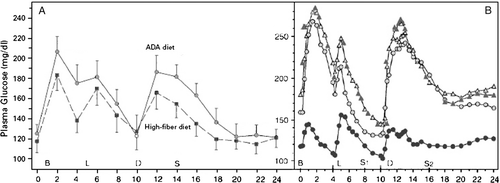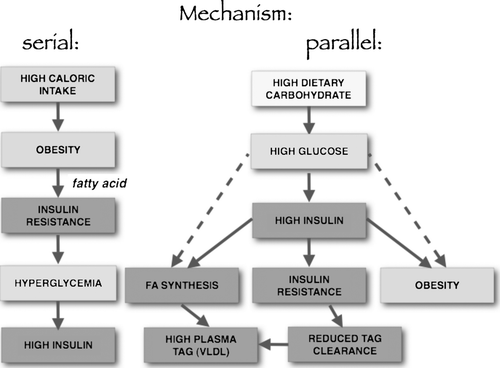Figures & data
Figure 1. Nutrient consumption in the United States. National Health and Nutrition Education Study (NHANES). Data from reference Citation6. B. Incidence of diabetes in the United States. Data from Centers for Disease Control and Prevention (http://www.cdc.gov/diabetes/statistics/incidence/fig2.htm)

Table I. Comparison of low CHO vs. LF diets on markers for Metabolic Syndrome Data shown in bold indicate low CHO (or mod-PROT) shows greater improvement in marker than LF; plain, LF is better. Original references in Volek & Feinman Citation5. Data below the double line are from experiments carried out under conditions designed to maintain body weight.
Figure 2. Effect of diet on plasma glucose. Meal points are Breakfast (B), lunch (L), dinner (D, snacks (S, S1, S2). A. Mean plasma glucose concentrations for 13 patients with type 2 diabetes followed two diets for six weeks: a diet containing moderate amounts of fiber (total, 24 g; 8 g of soluble fiber and 16 g of insoluble fiber), as recommended by the American Diabetes Association (ADA), and a high-fiber diet (total, 50 g; 25 g of soluble fiber and 25 g of insoluble fiber), containing foods not fortified with fiber (unfortified foods). Figure redrawn from reference Citation10. B. Mean plasma glucose concentration before (triangles) and after 5 weeks on control diet (light circles: (CHO:fat:protein = 55:30:15)) or 5 weeks on lower carbohydrate diet (dark circles: (20:50:30)). Data from reference Citation9.

Figure 3. Changes in markers of inflammation in people with metabolic syndrome with diet. Forty overweight men women with MetS were randomly assigned to an ad libitum very low carbohydrate ketogenic diet (VLCKD) (1510 kcal:%CHO:fat:protein = 13:59:28) or a low fat diet (LFD) (1521 kcal:%CHO:fat:protein = 56:24:20). Data from reference Citation3F.

